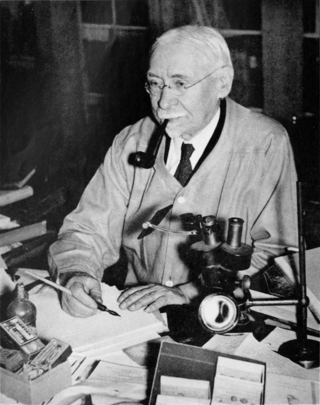
Henry Augustus Pilsbry was an American biologist, malacologist and carcinologist, among other areas of study. He was a dominant presence in many fields of invertebrate taxonomy for the better part of a century. For much of his career, his authority with respect to the classification of certain substantial groups of organisms was unchallenged: barnacles, chitons, North American terrestrial mollusks, and others.

Vertigo is a genus of minute, air-breathing land snails, terrestrial pulmonate gastropod molluscs or micromollusks in the family Vertiginidae, the whorl snails.

Pupilla is a genus of minute air-breathing land snails, terrestrial pulmonate gastropod mollusks or micromollusks in the subfamily Pupillinae of the family Pupillidae.

Ashmunella is a genus of small, air-breathing, land snails in the family Polygyridae.

Cerion is a genus of small to medium-sized tropical air-breathing land snails, terrestrial pulmonate gastropods in the family Cerionidae, sometimes known as the peanut snails. The genus is endemic to the Caribbean region.

Streptostyla is a genus of predatory, air-breathing land snails, terrestrial pulmonate gastropod mollusks in the subfamily Streptostylinae of the family Spiraxidae.

Euglandina is a genus of predatory medium- to large-sized, air-breathing, land snails, terrestrial pulmonate gastropod mollusks in the family Spiraxidae.

Urocoptidae is a family of air-breathing land snails, terrestrial pulmonate gastropod mollusks in the superfamily Urocoptoidea.

Pyramidula is a genus of very small, air-breathing land snails, terrestrial pulmonate gastropod mollusks or micromollusks in the family Pyramidulidae.

Holospira elizabethae is a species of air-breathing land snail, a terrestrial pulmonate gastropod mollusc in the family Urocoptidae.
Holospira mesolia, common name widemouth holospira, is a species of air-breathing land snail, a terrestrial pulmonate gastropod mollusk in the family Urocoptidae.
Guillarmodia is a genus of predatory air-breathing land snails, terrestrial pulmonate gastropod mollusks in the family Spiraxidae.

Urocoptoidea is a superfamily of land snails, gastropods in the suborder Helicina.
Opisthosiphon is a genus of land snails with an operculum, terrestrial gastropod mollusks in the family Annulariidae.
Epirobiidae is a family of air-breathing land snails, terrestrial gastropod mollusks in the superfamily Urocoptoidea.

Rabdotus is a genus of air-breathing land snails, terrestrial pulmonate gastropod mollusks in the subfamily Bulimulinae of the family Bulimulidae.
Holospiridae is a family of gastropods belonging to the superfamily Urocoptoidea of the order Stylommatophora. https://en.wikipedia.org/wiki/Special:Random Genera:













